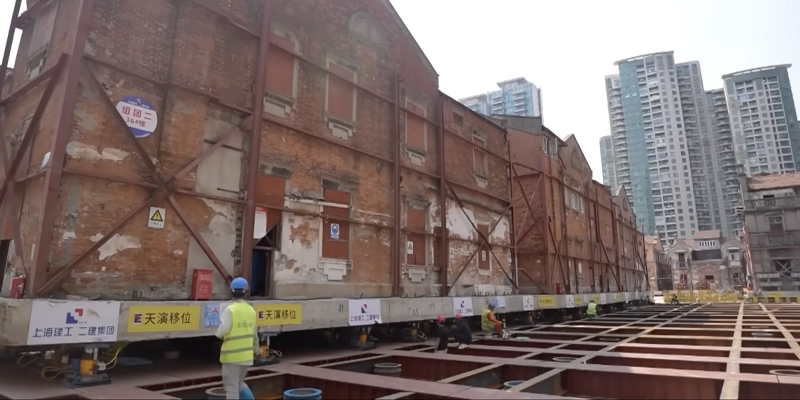July 11, 2025, 10:00am
Image from South China Morning Post on YouTube
Late in June, an entire city block in Shanghai stood up and walked back home.
8,270-tons of Shikumen style, brick row houses built in the 1920s, all 43,380 square feet from the courtyard stones to the rooftop tiles, strolled 300 feet home on 432 robotic feet. The project began two years ago, when a construction firm unleashed self-guided drilling robots beneath the Huayanli complex to dig out debris and dirt via thousands of feet of conveyor belts and make room for the hundreds of hydraulic feet, each able to lift ten tons. Once in place, the walking robots moved Huayanli 33 feet a day, or 0.0003 miles per hour, to the west then to the north, like a knight’s move in chess. With the block safely tucked to the side, a multi level mall, parking lot, and subway station was built underneath the block’s foundation, before the original city block took a three week trip to shuffle back and lower itself into place.
I came across the conclusion to this dizzying story on Geoff Manaugh’s excellent BLDGBLOG, where he takes the novelistic leap of imagining what an ambulatory city implies. He envisions buildings that can “dodge flash floods” and dancing structures that allow for “demented emperors requiring all their court’s buildings to be mobile, with urban-scale choreographers designing elaborate birthday fetes of architectural dressage.” He also predicts a futuristic heist on a large scale, grand theft arch. Why rob the safe from the bank if you can rob the bank from the block? (If you haven’t, check out Manaugh’s excellent A Burglar’s Guide To The City.)
But this kind of thing is more than just a great premise; my fascination with this story reminded me of why I love literature. Watching a city stand up is as exhilarating as reading a great sentence. A book can reshape how we see the world, like and afterimage burned into our retinas. Experiencing the most solid things imaginable lumber along on tiny feet is uncanny, it’s sublime. To the Burkean sublime fear and pleasure derived from “Sound and Loudness,” “Suddenness,” and “The Cries of Animals,” I’d add “City Blocks Walking.”
The sublime is encoded with terror, though. A roving city can easily be a nightmare: a home that can be a weapon, or chase you down, or as Manaugh imagines, stolen from you. Even the true facts of this construction project are horrifying if you shift the telling. Imagine moving back into your home and finding it exactly the same, in the exact same place, but knowing that it has gone somewhere in your absence and that something new and gigantic is writhing beneath it. Invention is not inherently altruistic or even optimistic.
Architecture, like great literature, imagines a different world and attempts to realize it in words, or on paper, or in stone and brick. They share the impulse of facing something as it is and imagining how it could be. It’s the “what if” behind every good story.
One of the engineers in Shanghai described the construction challenge as like a Huarong Dao sliding block puzzle. That description of playfulness on a grand scale is the joy of reading a well crafted novel, and seeing the puzzle pieces slide along in satisfying and surprising ways. The work requires shifting your lens: what if we turned this old block into a 21st century Baba Yaga hut?
And of course the impossibility of an engineering challenge can feel similar to the challenge of writing. Facing a blank page is like being asked to lift up a city block.
This whole thing is fascinating. If we live in a world where a city block can become a slow centipede crawling along seeking its home, what else is possible?
